Introduction
This document describes how to implement the Performance License on the Cisco Integrated Service Router 4000 (ISR4000) series routers.
Prerequisites
Requirements
There are no specific requirements for this document.
Components Used
The information in this document is based on these software and hardware versions:
- Cisco Integrated Service Router 4000 (ISR4000)
The information in this document was created from the devices in a specific lab environment. All of the devices used in this document started with a cleared (default) configuration. If your network is live, ensure that you understand the potential impact of any command.
Background Information
This document describes the implementation of the Performance License (also known as throughput license) on Cisco Integrated Service Router 4000 (ISR4000) series routers that run on Cisco IOS® XE software. Similar concept applies to the Cloud Service Router 1000 Virtual (CSR1000v) platforms.
Performance License
ISR4000 series routers are based on the multi-core Control, Data, and Services Plane CPUs and provide different performance levels that depend on the platform model.
Note: By default, each ISR4000 series model offers a base maximum throughput. For more information see the Product Overview site.
The Performance License increases the maximum throughput the device can provide.
In order to determine the throughput:
- Maximum throughput: Run the show platform hardware throughput level command.
- Current throughput: Run the show platform hardware qfp active datapath utilization command.
Router#show platform hardware qfp active datapath utilization
CPP 0: Subdev 0 5 secs 1 min 5 min 60 min
Input: Priority (pps) 0 0 0 0
(bps) 0 0 0 0
Non-Priority (pps) 54 59 142 295
(bps) 39728 51128 490672 1136960
Total (pps) 54 59 142 295
(bps) 39728 51128 490672 1136960
Output: Priority (pps) 0 0 0 0
(bps) 0 64 72 72
Non-Priority (pps) 14 6 100 255
(bps) 23200 14880 460904 1104712
Total (pps) 14 6 100 255
(bps) 23200 14944 460976 1104784 << consumed throughput
Processing: Load (pct) 0 0 0 0
Data Plane Cores on ISR4000
To explain the concept of Performance License, it is worth it to illustrate the difference between various models of ISR4000 in regard to their Data Plane architecture.
ISR4451 Data Plane
The ISR4451 can use up to nine Packet Processing Engine (PPE) cores for feature processing, encryption and decryption included, and a single core for Input and Output (I/O) processing. Each PPE core can handle one packet at a time.
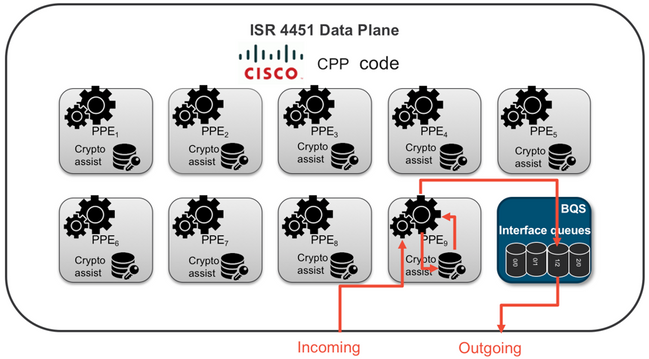
ISR4431 Data Plane
The ISR4431 has the same Data Plane architecture as ISR4451 except it can use up to five PPE cores for feature processing, encryption and decryption also included.
ISR4351 and ISR4331 Data Planes
The ISR4351 and ISR4331 Data Plane architecture consists of up to three PPE cores used for feature processing, and a single core for both I/O and crypto processing.
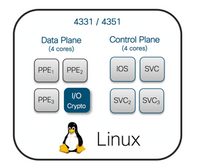
ISR4321 and ISR4221 Data Planes
The ISR4321 and ISR4221 have a single PPE core for feature processing, and another core for I/O and crypto processing.
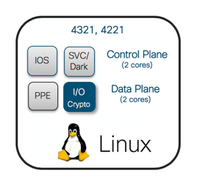
Performance License Comparison
Differences on each ISR4000 series routers before and after the Performance License is applied:
|
|
No Performance License
|
With Performance License
|
|
|
Max throughput
|
PPE Cores
|
Max throughput
|
PPE Cores
|
|
4221
|
35 Mbps
|
1 x PPE + 1 x I/O
|
75 Mbps
|
No change
|
|
4321
|
50 Mbps
|
1 x PPE + 1 x I/O
|
100 Mbps
|
No change
|
|
4331
|
100 Mbps
|
2 x PPE + 1 x I/O
|
300 Mbps
|
3 x PPE + 1 x I/O
|
|
4351
|
200 Mbps
|
2 x PPE + 1 x I/O
|
400 Mbps
|
3 x PPE + 1 x I/O
|
|
4431
|
500 Mbps
|
3 x PPE + 1 x I/O
|
1 Gbps
|
5 x PPE + 1 x I/O
|
|
4451
|
1 Gbps
|
5 x PPE + 1 x I/O
|
2 Gbps
|
9 x PPE + 1 x I/O
|
|
4461
|
1.5 Gbps
|
8 x PPE + 1 x I/O
|
3 Gbps
|
15 x PPE + 1 x I/O
|
Configuration
Activate Performance License on ISR4000
Before the Performance License can be applied, one of several prerequisites need to be met. These depend on the license model (Smart or Traditional).
Smart Licensing
Register the device to the Smart/Virtual Account and ensure the proper Performance License is provisioned to the account.
Note: Cisco IOS XE 16.10.1 and newer software versions are Smart License only, traditional licenses are no longer supported.
Cisco IOS XE 17.3.2 and newer software versions support the Smart Licensing Using Policy . This policy provides a simplified approach.
Right To Use (RTU) License
Accept the End User License Agreement (EULA) in global configuration mode, license accept end user agreement. After EULA is accepted, the demo or evaluation RTU Performance License is activated. The evaluation period expires after 60 days.
Traditional License
Copy the license file to the router flash. Use the license install <flash:license-file> command to install it.
Configure the Throughput Level
Use the platform hardware throughput level command in global configuration mode in order to activate the Performance License.
Router(config)#platform hardware throughput level 300000
% Please write mem and reload
% The config will take effect on next reboot
Note: On the CSR1000v, changes are applied immediately, and no reload is required. To activate the license on the ISR4000 routers, a reload is required.
When the Performance License is activated on the ISR400 routers:
- An additional Data Plane Core(s) for forwarding is activated (not applicable to ISR4221 nor ISR4321).
- The build-in Aggregate Shaper is adjusted to the licensed bandwidth.
The Aggregate Shaper functionality is implemented in the Data Plane CPU core dedicated to I/O operations.
Tip: The licensed throughput is applicable to QFP Egress (outgoing traffic). The Performance License congests the Data Plane external interface output when outgoing traffic exceeds the licensed throughput. By default, the excess traffic is shaped. On other platforms, a policing-based option is available.
Traffic Charged Against the Performance License
Traffic Charged Against The License
- All egress traffic sent to a physical interface (except management interface GigabitEthernet 0)
- Traffic through the UCS-E on the internal Service Module (logically it is an external device)
Traffic Not Charged Against The License
- Ingress traffic
- Traffic punted to control plane
- Traffic scheduled for virtual interfaces such as MFR and MLPPP (is charged once scheduled out a physical member link)
- Traffic switched within a switch module or between modules over Multi Gigabit Fabric in the same VLAN (such traffic does not reach Data Plane cores)
When Traffic Exceeds the Licensed Throughput
A token bucket system (bit count) is implemented on the I/O Data Plane core to determine if the packets can be sent through an egress interface. Traffic shaping is applied when more bits are destined for external interfaces than the license allows for.
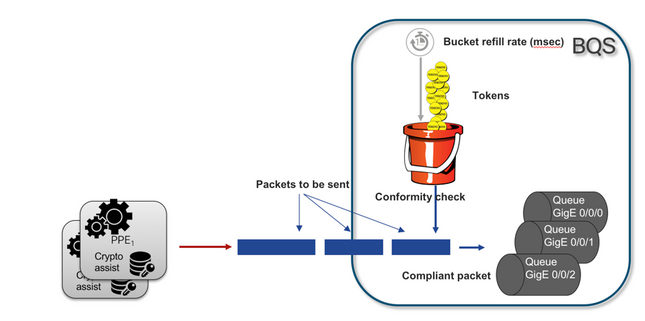
Packets can be sent as long as there are tokens in the bucket:
- No more tokens available: The packets are buffered.
- New tokens available in bucket: The buffered traffic is sent out in the hypothetical Hierarchical QoS Framework (HQF) representation, a separate shaper node is introduced over the external physical interfaces level.
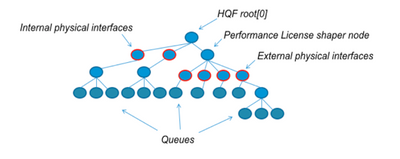
This pseudo-configuration uses Modular QoS CLI (MQC) in order to illustrate the general concept:
policy-map Data PlaneExternalInterfaces
class GigabitEthernet0/0/0
bandwidth remaining ratio 1
service-policy <user defined>
class GigabitEthernet0/0/1
bandwidth remaining ratio 1
service-policy <user defined>
class Serial0/0/0
bandwidth remaining ratio 1
service-policy <user defined>
policy-map License
shape average license_level
service-policy Data PlaneExternalInterfaces
policy-map Root
class external_traffic
service-policy License
class control_plane_traffic
service-policy Punt
class recycled_traffic
service-policy RecycleNote: Each external interface has the same bandwidth remaining ratio.
If the offered rate exceeds the licensed bandwidth:
- The scheduler queues packets and schedules interfaces with equal bandwidth remaining ratio.
- Some packets can be dropped due to queue limit exceeded.
- Latency and jitter can increase for non-LLQ traffic. Priority traffic is less affected because it gets some limited credits to bypass the license temporarily.
- Due to oversubscription, all external interfaces are congested simultaneously; the risk of Out Of Resources (OOR) condition increases.
Through any period of oversubscription, the interfaces share the bandwidth equally, unless one has priority level traffic.
Note: By default, the built-in shaper does not differentiate between LAN/WAN interfaces. As a result, all interfaces queue packets when the aggregate egress traffic exceeds the licensed throughput. In such scenarios, QoS policies can be implemented to prioritize and weight traffic on all interfaces – not just the WAN interface(s).
Verification
Licensed Bandwidth Exceeded Symptoms
Indicators of throughput limit:
- Total Egress traffic capped at licensed throughput in the output of show platform hardware qfp active datapath utilization:
Router#show platform hardware qfp active datapath utilization
CPP 0: Subdev 0 5 secs 1 min 5 min 60 min
Input: Priority (pps) 0 0 0 0
(bps) 0 0 0 0
Non-Priority (pps) 18027 17536 17493 17740
(bps) 101806904 184352 195272 204816
Total (pps) 18207 17536 17493 17740
(bps) 101806904 184352 195272 204816
Output: Priority (pps) 0 0 0 0
(bps) 0 0 0 0
Non-Priority (pps) 17916 17400 17361 17578
(bps) 99956512 198024 209024 218568
Total (pps) 17916 17400 17361 17578
(bps) 99956512 97592394 98694332 94902000
Processing: Load (pct) 7 7 7 7
Note: This example is based on 100Mbps.
- Tail Drops reported on the Data Plane level in the output of show platform hardware qfp active statistics drop:
Router#show platform hardware qfp active statistics drop
-------------------------------------------------------------------------
Global Drop Stats Packets Octets
-------------------------------------------------------------------------
TailDrop 4395 6634970
Router#show platform hardware qfp active feature lic-bw oversubscription
Interface: GigabitEthernet0/0/0, QFP interface: 7
Overall Traffic:
enqueued (bytes): 7188433, (packets): 75926 << signs of evenly distributed buffering on interfaces
tail_drops (bytes): 0, (packets): 0
total (bytes): 7188433, (packets): 75926
Interface: GigabitEthernet0/0/1, QFP interface: 8
Overall Traffic:
enqueued (bytes): 10492353355, (packets): 236972715 << signs of evenly distributed buffering on interfaces
tail_drops (bytes): 18809589, (packets): 56020 << drops on busy interfaces
total (bytes): 10511162944, (packets): 237028735
Interface: GigabitEthernet0/0/2, QFP interface: 9
Overall Traffic:
enqueued (bytes): 9544293, (packets): 57041 << signs of evenly distributed buffering on interfaces
tail_drops (bytes): 0, (packets): 0
total (bytes): 9544293, (packets): 57041
Note: The counters are incremented for each packet processed under licensed throughput in an oversubscription event. It increments an enqueue counter for those that are buffered, and a drop counter when the packet has to be discarded.
- Syslog message generated when the average throughput rate approaches or exceeds the licensed bandwidth.
%BW_LICENSE-4-THROUGHPUT_MAX_LEVEL: F0: cpp_ha: Average throughput rate approached the licensed bandwidth of 100000000 bps during 1 sampling periods in the last 24 hours, sampling period is 300 seconds
The alert threshold is configurable. The syslog message can be used as an indicator for the licensed bandwidth.
To configure the threshold level and sample interval, use the set platform hardware throughput-monitor threshold [percentage] interval [seconds] command.
To display the throughput monitor settings, use the show platform hardware throughput-monitor parameters command:
Router#show platform hardware throughput-monitor parameters
Throughput monitor parameters
Throughput monitor threshold: 90 percent
Throughput monitor interval: 300 seconds
Throughput monitor status: enabled
Boost Performance License
The ISR4000 platforms offer a boost performance license that allows for an unthrottled Cisco Express Forwarding (CEF) performance. The device must use Cisco IOS XE software version 16.7.1 or later. The aggregate shaper is disabled after the boost license is activated, as a result, the maximum throughput depends on the features used and it is no longer deterministic.
Activate Boost Performance License
Traditional Licenses
Installation:
- Upload the license file to the router flash.
- Install the license.
- Save the configuration.
- Reload the device to activate the Boost Performance license.
After the license installation, the Boost Performance is enabled automatically, and the platform hardware throughput level boost command is added to the configuration.
Use the show license command to see the license state.
Router#show license
<output ommitted>
Index 11 Feature: booster_performance
Period left: Life time
License Type: Permanent
License State: Active, In Use
License Count: Non-Counted
License Priority: Medium
Smart Licensing Previous Versions and 17.3.1
Installation:
- Ensure the correct Boost Performance license (specific to the ISR4000 model) is provisioned on the Virtual Account.
- Register the device to that Virtual Account.
- Use the platform hardware throughput level boost command in global configuration mode.
- Save the configuration.
- Reload the device to activate the Boost Performance license.
Note: In Cisco IOS XE 17.3.1 and older versions, the platform hardware throughput level boost command is only available after a successful registration in CSSM. The command is not available if the device had been registered in CSSM before the license is added to the Virtual Account license repository. You have to unregister and reregister the device to CSSM to execute the platform hardware throughput level boost command.
Use the show license all command to see the license state:
Router#show license all
<output ommitted>
License Usage
==============
Boost Performance for ISR4431 (ISR_4431_BOOST):
Description: Boost Performance for ISR4431
Count: 1
Version: 1.0
Status: AUTHORIZED
Smart Licensing Newer Versions to 17.3.2
In Cisco IOS XE 17.3.2 and newer software versions, there is no concept of device registration with Smart Licensing portal (Smart/Virtual Account). Unenforced licenses get activated upon the configuration change, and later on the license usage is expected to be reported to Cisco as per policy. For more information see the Smart Licensing Using Policy site.
Additionally, in Cisco IOS XE 17.3.2 onwards, the Boost Performance license becomes a Right-To-Use (RTU) license. This means you do not need a prior authorization to activate this license.
Installation:
- Use the platform hardware throughput level boost command in global configuration mode.
- Save the configuration.
- Reload the device to activate the Boost Performance license.






 Feedback
Feedback